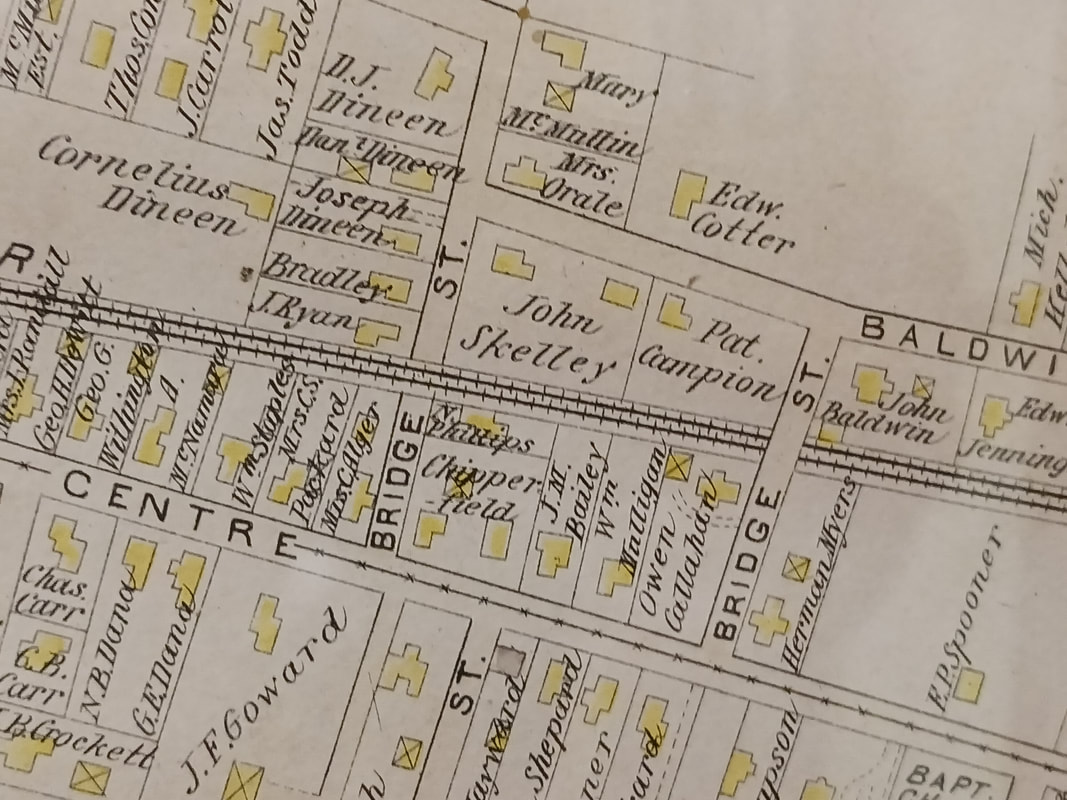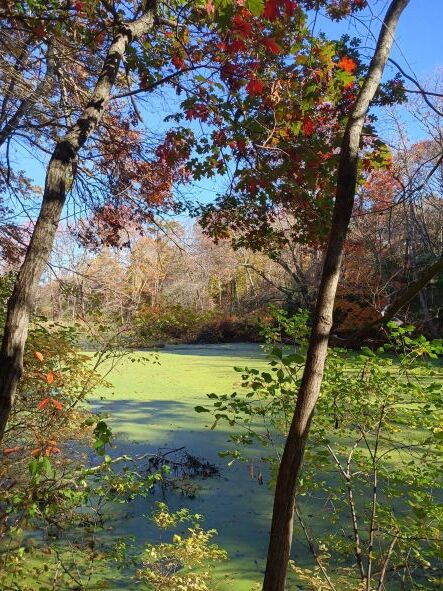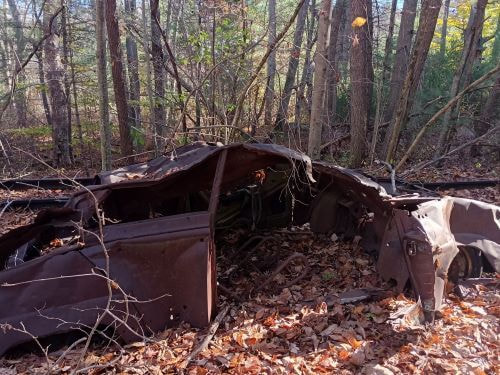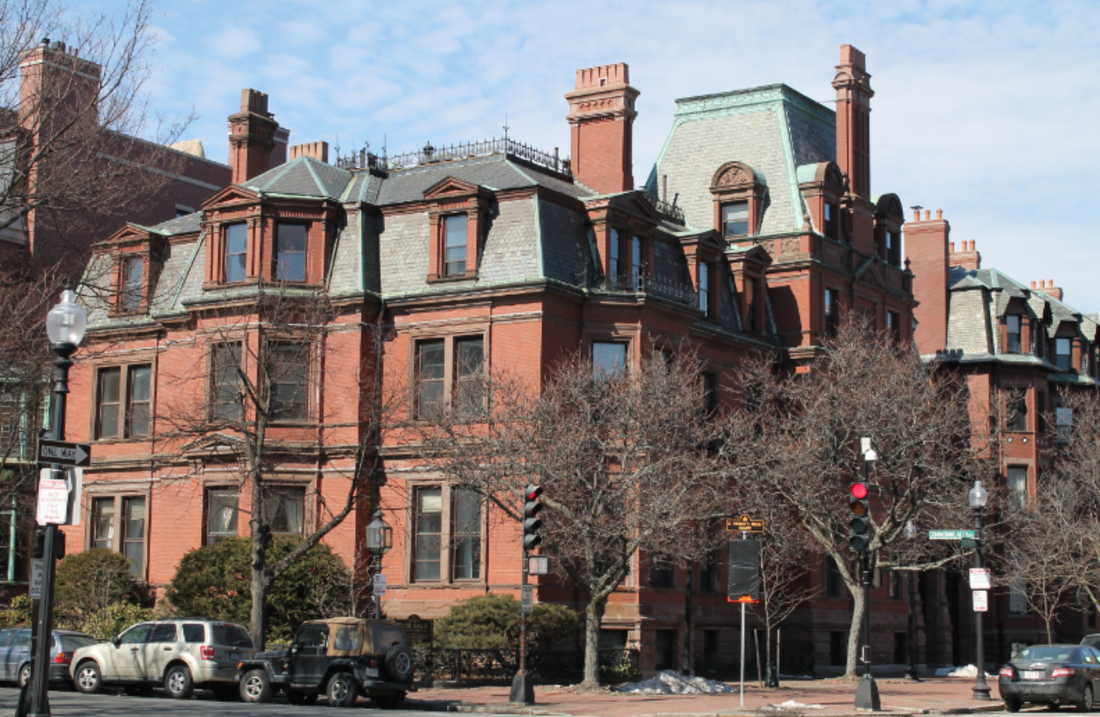|
Although the railroad played a large role in the development of Easton as an industrial community, the trains are long gone. But remnants of their existence remain. With a couple of interruptions, it is possible today to walk the train's route from the Stoughton line, through North Easton, Easton Center, all the way into the Hockomock Swamp, ending up behind the old dog track in Raynham. I've been walking the railroad tracks. Last week, on a beautiful fall day, I walked from the Stoughton line, west of Roche Bros Supermarket and approximately parallel to Washington Street, to the Historical Society and Museum on Mechanic Street. Between Stoughton and Elm Street are two wooden bridges, one more damaged than the other, that cross Whitman's Brook. 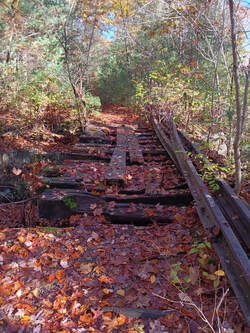 Damaged bridge over Whitman's Brook View off the path Occasionally, trails lead off the path beside the tracks, leading to hidden vistas worth checking out. The above view was down a path on the right, off the line, heading south. After crossing Elm Street and reaching the Historical Society I continued up Sullivan Ave., toward Main, and passed another bridge that carries the tracks above street level. Walking on, I slipped through a tear in the fence and hazarded a treacherous descent down to the tracks and the wall of dirt and vegetation packed under Main Street where a bridge once crossed. Chet Raymo, Easton resident, noted author, and professor emeritus at Stonehill College, wrote in his book, The Path, published in 2003, about his regular walk from his home on Main Street in North Easton, through Sheep Pasture, to his job at Stonehill, that "Measured from end to end, the path described......is hardly more than a mile, but the territory it traverses is as big as the universe." The railroad tracks run less than seven miles through the Town of Easton but there is an entire universe here. Like Raymo, I try to observe every detail of my route. Three days later, I continued walking. Between Main Street and Bridge Street the path is difficult but from Bridge to Depot it is clear. Bridge Street has an interesting history. The Village of North Easton map (1895) shows Bridge Street was originally an (upside down) U. If you drive up Bridge Street from Center today, turn left to stay on Bridge Street, and at the bottom of the hill turn left again you run into rocks blocking what used to be part of Bridge Street, crossing the railroad tracks to Center Street. When I first began driving in the 1970's, a car could cross here to Center Street. Today there is a sign where the road meets Center, for 'Center Street Rear'. In the photo on the top, from the map View of North Easton, Mass, 1881, is the part of Bridge Street (never a bridge) crossing from Williams Street to Center, heading west. On the bottom, the map Village of North Easton, 1895, showing the U-shaped Bridge Street. Continuing on, it is easy to access the tracks from the outdoor chapel behind the Covenant Congregational Church on Center Street. There, on the far side of the tracks, is a wet area sometimes called 'The Muck'. In the past, young people fished and skated, and in at least a few cases, even swam there! Some of its 'muckiness' comes from the fact that it absorbed run-off from the old Easton dump that sat at the bottom of Baldwin Street and operated until 1972. I also passed an old, rusted automobile shortly before arriving at Depot Street. The Muck Old car near Depot Street The Easton Center train station, which no longer exists, was located on Depot Street near Fernandes Lumber and Home Center. Today, a building (possibly the ticket office) that was once part of the station complex is located a short distance away from its original location, behind the Evangelical Congregational Church at 351 Depot Street. Easton Center Depot
I plan to complete my walk of the train line as it travels through Easton. (Once the bears are in hibernation.) In North Easton, tracks remain, but by 1968 all of the tracks south of Easton Center were removed, and there is only a dirt path. I will pay attention as I go. In addition to history, architecture, and industry, we appreciate our town's natural beauty and green spaces. Some are well-known and well-visited: Borderland, Wheaton Farm, Sheep Pasture, but some are still somewhat hidden and a joy to stumble upon. In The Path, Chet Raymo writes that most of us will find our purpose "on the local scale, along paths that begin at our own front door." Anne Wooster Drury The frogs in the pond are a Memory now, gone wherever Frogs go when the wind scrapes Dry leaves along the pavement eastonmahistoricalsociety.org 508-238-7774
1 Comment
John Conant
11/10/2022 11:33:54 am
We did not receive an email enclosing the November 5th bi-monthly issue, although we did receive Oct. 29th. We have followed these emails for years and, living in Florida, would greatly miss them.
Reply
Your comment will be posted after it is approved.
Leave a Reply. |
Author
Anne Wooster Drury Archives
June 2024
Categories |
Easton Historical Society and Museum
PO Box 3
80 Mechanic Street
North Easton, MA 02356
Tel: 508-238-7774
[email protected]



